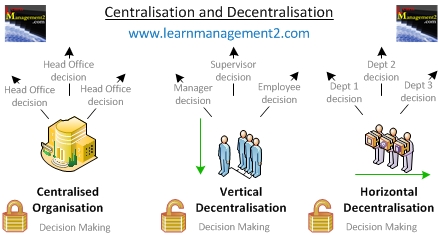In a centralised organisation head office (or a few senior managers) will retain the major responsibilities and powers. Conversely decentralised organisations will spread responsibility for specific decisions across various outlets and lower level managers, including branches or units located away from head office/head quarters. An example of a decentralised structure is Tesco the supermarket chain. Each store of Tesco has a store manager who can make certain decisions concerning their store. The store manager is responsible to a regional manager.
Centralised and Decentralised CombinedOrganisations may also decide that a combination of centralisation and decentralisation is more effective. For example functions such as accounting and purchasing may be centralised to save costs. Whilst tasks such as recruitment may be decentralised as units away from head office may have staffing needs specific only to them.
Vertical DecentralisationCertain organisations implement vertical decentralisation which means that they have handed the power to make certain decisions, down the hierarchy of their organisation. Vertical decentralisation increases the input, people at the bottom of the organisation chart have in decision making.
Horizontal DecentralisationHorizontal decentralisation spreads responsibility across the organisation. A good example of this is the implementation of new technology across the whole business. This implementation will be the sole responsibility of technology specialists
Advantages of Centralised Structure For Organisations
|
Advantages of Decentralised Structure For Organisations
|
| Senior managers enjoy greater control over the organisation. | Senior managers have time to concentrate on the most important decisions (as the other decisions can be undertaken by other people down the organisation structure. |
| The use of standardised procedures can results in cost savings. | Decision making is a form of empowerment. Empowerment can increase motivation and therefore mean that staff output increases. |
| Decisions can be made to benefit the organisations as a whole. Whereas a decision made by a department manager may benefit their department, but disadvantage other departments. | People lower down the chain have a greater understanding of the environment they work in and the people (customers and colleagues) that they interact with. This knowledge skills and experience may enable them to make more effective decisions than senior managers. |
| The organisation can benefit from the decision making of experienced senior managers. | Empowerment will enable departments and their employees to respond faster to changes and new challenges. Whereas it may take senior managers longer to appreciate that business needs have changed. |
| In uncertain times the organisation will need strong leadership and pull in the same direction. It is believed that strong leadership is often best given from above. | Empowerment makes it easier for people to accept and make a success of more responsibility. |

No comments:
Post a Comment